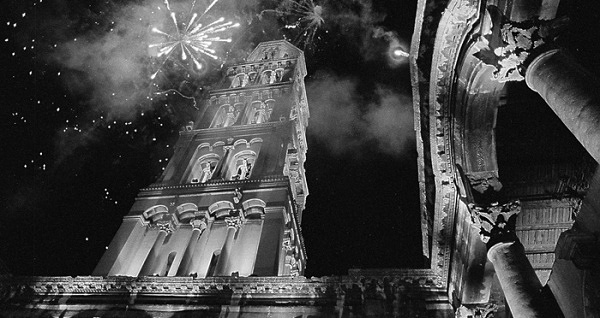A Wonderful Night in Split / Ta divna Splitska noć (dir. Arsen A. Ostojic, Croatia, 2004)
The saying goes that there is no such thing as bad publicity, but A Wonderful night in Split is not exactly the kind of advertising you would want for your summer town on the Adriatic. Shot entirely inside Diocletian’s Palace, the film goes against the grain of what you would expect from such a location: it’s colorless, cold and dark, and the only relation to the Mediterranean are four drunk American sailors in search of a prostitute.
We don’t see much of Split in this film and the wonderful is also questionable. The film is in fact a multiple narrative of the same moment (the night hours at the turn of the year), viewed from the perspective of different characters crossing each other’s paths. Four main characters emerge as protagonists: a drug dealer, a teenage junkie girl and a young couple looking for a place to make love. Not one of these stories (nor those of other secondary characters) ends on a happy note. There is however plenty of night.
And from a pure cinematographic perspective, it is a wonderful night. Director of photography Mirko Pivcevic was nominated with this film for a prestigious Golden Frog at the 2005 Camerimage. His excellent skills in lighting up a night scene in sharp black and white makes this a great film to watch even with no subtitles, and probably the end result should be credited to him as much as to director Arsen A. Ostojic.
While the cinematography is perfect, the film as a whole is much more uneven. This comes mainly from the desire to do everything in just one film. A Wonderful Night in Split ticks every box in the cinephile guide to modern filmmaking: the black & white, the multiple perspectives, the fragmented narrative, the use of genre clichés and so on. Of course, when you’re doing something that’s very ambitious it’s very possible that you’re not going to get everything right, but the real problem is that there are just too many directions that split (pun intended) the coherence of the film, and too many references that undermine it’s originality.
And with so many things going on, another problem arises: you start to wonder if some of them are really clever postmodernist references or just accidental results (if not bad filmmaking). In the Q&A after the screening at the altcineAction! Online Short Film Festival, the film editor said he saw some mistakes. He gave the example of one lovemaking scene between the two teenagers, which is shot, edited and scored as a romantic scene in a pop music video. That was exactly my thought, only I didn’t see it as a mistake but as a deliberate use of MTV imagery and romcom clichés, intended to build an ironic contrast to their actual situation. I can appreciate the mind and erudition behind all this, but with less diversity of style maybe the film would have flowed more smoothly (though it’s hard to say if that would have made it a better film).
Cinematography aside, up until the last segment of the story I was still in doubt whether this was a good film or a not so bad film, and even whether I like it or not. I decided it was a very bad film the moment it seemed the writer-director was going to go the same path with this segment as with the other two. When the two lovers high on LSD climb on top of the tower, and the crowd on the ground starts screaming „Jump! Fly!”, it felt like a cheap trick, and even cowardice on behalf of the director. To serve tragedy after tragedy, and then to promise some ray of sunshine (the segment is quite funny until then), but only to deliver the same recipe again: build up empathy for the characters and then destroy them. At this point either they fall and this story ends like the rest, or they crawl back inside, but then all the tension has been build for nothing, an emotional rollercoaster of cheap thrills with a contrived happy ending.
At the very end of the film I changed my mind once again. There was a third option, something I had only seen in Dreyer’s Ordet. To pull this off, to build that kind of anticipation and emotion that the spectator is only too eager to forgive this sudden breach of coherence and accept the miracle, that alone would have made this a good film.

